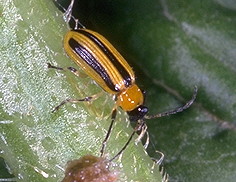Several species of armyworm (Spodoptera spp.) and looper (Trichoplusia spp.) larvae can also damage pumpkins. These larvae feed on foliage and occasionally damage fruit. They can be controlled with registered insecticides and biological controls such as Bacillus thuringiensis.
-
Cucumber Beetles: (Acalymma vittatum, Diabrotica undecimpunctata)

These beetles are vectors of bacterial wilt. Plants infected with the disease wilt quickly with leaves drying out prior to plant death. The causative bacteria, Erwinia tracheiphilia lives in the bodies of these beetles, which introduce the bacteria into the plants through the fecal contamination of feeding wounds. This is the only natural method of infection known. Beetles also spread squash mosaic
virus.
Damage:
Cucumber beetles are important pests of cucurbits. They cause four types of damage. Seedling destruction, flower and foliage damage, root feeding, and transmission of bacterial wilt disease. The beetles feed on newly emerged cotyledons and stems, and they have been reported to go below ground level and feed on plants as they emerge. Adults lay eggs in the soil near the seedlings and larvae soon hatch and begin feeding on roots of the cucurbits. Larvae chew holes and tunnel into the roots. Damage by the larvae, except under dry conditions, is usually considered minor. Probably the most serious damage by cucumber beetles is from transmission of bacterial wilt. Bacterial wilt can kill many plants in a field and seriously reduce the yield. The striped cucumber beetle and the spotted cucumber beetle have very similar life cycles and both can carry the bacteria, but both are not equally important pests on cucurbits
.
Control Practices:
Chemical control is often needed, particularly in commercial plantings. To prevent cucumber beetle damage to seedlings, treat when one beetle per 10 feet of row is found. To prevent bacterial wilt, treat when one beetle per 100 feet of row is found. Usually, a soil insecticide is used at planting time for control of cucumber beetles during the seedling stage and foliar treatments are applied as needed.
Insecticides:
Application of an insecticide is usually recommended as soon as the plants begin to emerge through the soil. For prevention of bacterial wilt, it is often advisable to spray at 5-day intervals, beginning when seedlings emerge or after transplanting and continuing the schedule until vines run. If rain occurs within the 5-day period, repeat the treatment promptly and then return to the regular 5-day treatment interval.
Sprays prepared from wettable powders are less phytotoxic than sprays prepared from emulsifiable concentrates. Malathion® may cause injury to plants if applied before they start to vine. Malathion® may cause some foliar burning and should not be applied when plants are wet.
Viruses:
Viruses cause some of the most serious diseases of pumpkins. Of the viruses affecting pumpkins are those of most importance are transmitted by aphids, whiteflies, leafhoppers, and beetles. Virus transmission is specific, however. Viruses such as cucumber mosaic virus (CMV), watermelon mosaic virus (WMV), and papaya ring spot virus (PRV) are transmitted by aphids in a non-persistent manner, requiring only seconds to a few minutes for the aphids to probe the leaf surface and transmit the virus.
If possible, other cucurbits should not be grown in the same area prior to planting pumpkins to avoid movement of virus from one crop to another. It is always desirable to plant succeeding crops of pumpkins or other cucurbits upwind of previously planted cucurbit crops. Other crops such as peppers may also harbor a number of viruses that can also affect neighboring cucurbit crops.
Download Entire Document (*.pdf) 

